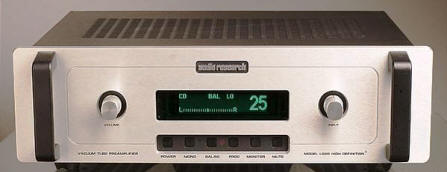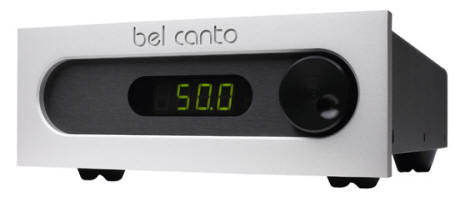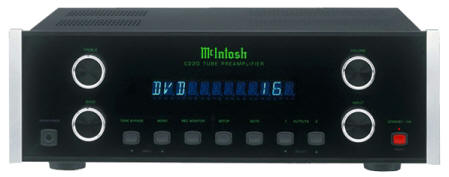We will not be talking about the ability of these popular preamplifiers to transport you to musical bliss or to bring musicians into your listening room. This survey is not about the musical performances of these components and how the bass, midrange, treble, or soundstage is more or less like the “real thing”. Of course, the subject of fidelity to the original source is controversial because any sound recording engineer will tell you that even though they are closer to the actual musical performance than a listener at home will ever be, the sound in their control room, being recorded live, sounds very differently than the sound on the other side of the thick glass window.
Preamplifiers are the “necessary evil” of audio systems. Switching between sources could be accomplished with very minor sonic penalties. Controlling the volume without harming the extremely delicate audio signal, however, is the big challenge in designing a good preamplifier. The huge variety of volume control designs makes this point clearly: track-and-wiper potentiometers, discrete-resistor potentiometers (several configurations), switched resistor arrays (both IC and discrete), voltage-controlled amplifiers (VCA), multiple-winding transformers, and other technologies are available. Various techniques of dealing with voltage and impedance matching, such as vacuum tubes, transistors, linear buffers, transformers, and even optical transfer can be found. Each scheme has advantages and disadvantages both in terms of cost and performance, which implicitly means that any preamplifier using any of these parts is a compromise. Your mission, that you have accepted, is to decide which of these compromises are acceptable to you based on your personal view of how you like your music to sound, and what is financially possible.
Besides source switching, the goal of a stereo preamplifier is to provide the widely accepted function of being a straight wire with gain, imposing absolutely no character, change, distortion, or any alteration of the audio signal. The most reliable way to evaluate how successful a preamplifier is at attaining this goal is with bypass testing. Bypass testing allows for adding or removing only the preamplifier from an otherwise unchanging playback system, allowing precise audio inspection of the intrinsic sound of the preamplifier and any deviations from neutrality.

For our purposes, we will be comparing the three preamplifiers in this survey to the output of the very musical Prism Orpheus Digital Interface, which is a 24 bit 192 kHz analog-to-digital and digital-to-analog (AD/DA) converter which can also function as a standalone, balanced preamplifier with its own front-panel volume control. Since the Orpheus is an outstanding source component which offers LP Replacement Quality™ sound, it is able to provide sufficient resolution for our purposes. I have recorded many of my favorite LPs to 24/192 WAV files, which, while not quite indistinguishable from listening to the original vinyl discs, are so close as to make differences apparent as quantity and not quality variances from the original. So with an excellent source component and the ability to insert a preamplifier into the signal path using the same balanced interconnects, adding nothing to the playback system except the preamp being tested, we have an ideal test rig to perform reliable bypass evaluations of how well each of these preamplifiers meets the goal of providing a transparent, straight wire with gain.
The Orpheus has an output impedance of 100 Ohms balanced and all of the preamplifiers discussed below have high enough input impedances that any problems from electrical interactions between components should be both consistent and minimal. Power amplifiers included Manley Snappers, Jones Audio PA-M300, Parasound JC-1, Nuforce Ref 9 v2SE, and Marantz MA-9S2s, all with input impedances high enough to work well with any of the preamplifiers. Speakers included YG Acoustics Kipod Main Modules and Dali Euphonia RS3s, with help in the bass from pairs of JL Audio f112 and Velodyne Optimum-12 subwoofers.
Given all of the above, this survey is not going to be a love-fest of audio delights, but a critical evaluation of audible deviations from absolute neutrality.
I have enjoyed other preamplifiers from Audio Research Corporation, including the LS25 mk. 2 and LS22, and waited anxiously and with anticipation for the opportunity to audition the LS26 in my system. ARC declined to provide a preamplifier for review, so I bought one. The other preamplifiers were also purchased for this survey. I instantly liked the large numeric readout of the volume setting for two reasons: the “large” part is very helpful to me since I often listen while wearing reading glasses and taking notes. (If you don’t see why this is a notable feature, just wait a few years. You will understand.) The “numeric” part is a valuable aid to assure repeatable volume settings when swapping components. A new pair of matched, low-noise 6H30 tubes was given about 50 hours of burn-in before critical listening.

The $6500 Audio Research LS26 vacuum tube preamplifier has very low noise, which we have come to expect with modern vacuum tube components. Triangles and bells ring for a very long time before fading into silence. However, as they fade, these delicate harmonic overtones lose body and their quality becomes lighter and thinner, which is not true to the source signal. The upper treble is very extended and even, with no highlighting of a particular frequency range. Even so, very high frequency sounds become splashy and cymbals often sound like white noise instead of disks of shimmering metal.
Voices are markedly thinner and with less body than when the preamplifier is bypassed. The reduces the sense of the singer having a physical presence in the room and removes the listener from the original performance venue and space, like listening to the performance on very good small monitors instead of being in the room with the artists. This relatively depressed or recessed midrange, which typifies the ARC house sound (although largely absent in the LS22), accentuates the upper midrange and lower treble creating a false feeling of presence and detail. A good example of the change of character that results from this aberration is when listening to the wood sticks on Dire Straits “Water of Love”. Through the LS26, these sound more like chopsticks.
Spatially, the LS26 has very good 3-D effect with excellent left-to-right placement of musicians. The sound stage is also very deep, although the stage narrows towards the rear creating a somewhat triangular or rounded rear of the stage.
The LS26 is not the preamp to use if you are looking to warm up a system with “tube sound”. (Please see the McIntosh C220 below if you want this effect.) Part of my auditioning and review process is seeking the next reference component, often hoping that the unit under review could replace the current reference and earn a long term presence in my system. The LS26 has received some very positive user comments, but as I listened to the LS26 and identified its effect on the music, I felt my hopes for this popular preamp earning reference status quickly fading.

The $1700 Bel Canto e.One PRe3 solid state preamplifier is far more neutral than the LS26. The bass is slightly soft with impact and resolution that are both less than the bypass. Dynamic impact suffers just a bit less than bass resolution does. These differences are noticeable with a bypass test, but are easily dismissed for their negligible impact on one’s enjoyment of music.
The midrange is slightly leaner than bypass with a typical solid-state sound encroaching on vocals. Singers are edgier and sharper. Sibilants break down into harshness sooner than the bypass on recordings of marginal quality. This small leanness extends evenly across the midrange and treble without highlighting a narrow band of frequencies and is therefore not too bothersome. The midrange does not sound wrong, sterile or forward and vocal performances maintain their believability, especially with the Manley Snapper amplifiers.
The sense of solid-state leanness results in slightly smaller recording space. Large halls seem not quite as open and are more limited in size. This actually has a benefit for some studio recordings by compensating for overuse of artificial reverb and delay that attempt to give the recordings a feeling of a larger acoustic environment. The effect is that some studio recordings are better focused and clearer than the bypass.
On Bruce Springsteen’s “One Step Up” on the Tunnel of Love LP, the PRe3 offers excellent resolution of the tambourine’s complex harmonic sound. On the same cut, Patty Scialfa’s voice does not stand out quite as individually in the mix as heard in bypass, but her voice is not prominent in the original recording, anyway. The treble is a bit less rich and is wispier than bypass, but quite satisfying nonetheless.
The other preamps have narrow band deviations from neutrality that are intrusive. These deviations could, possibly, be mitigated with careful cable choices although using interconnects as deliberate band-aids to fix problems is not a satisfying, long-term solution to building an enjoyable audio system. To be avoided for the PRe3 are cables that are unusually bright, forward, crisp, or über detailed. The Bel Canto is very sensitive to power cords, and I found good neutrality with a PS Audio PerfectWave AC-10 power cord.
There is a small reduction in stage depth, with excellent performance into the rear corners. The left-to-right placement of musicians is very close to bypass. The Bel Canto offers very precise control of volume, where I felt that the LS26’s volume steps were often too large for setting the volume exactly as I needed it. Overall, the sound quality of the PRe3 is very similar to the $7500 Marantz Reference Series SA-7S2 preamplifier.
The PRe3 is much more faithful to the sound of the source than a Pass Labs X-1 that visited briefly. The Bel Canto has higher resolution, richer harmonics and is simply better sounding than the $6000 two-box Pass Labs preamp. I found the grain-free sound of the PRe3 to be close to no sound at all, and using interconnects that feature natural harmonic depth helps this preamplifier to offer excellent performance.

The $3300 McIntosh C220 vacuum tube preamplifier has a distinct character. Think “classic vacuum tube sound”, like an updated Conrad-Johnson PV 5. The bass is full and rich with accurate pitch and power, only falling short when presenting a clean leading edge to bass notes. This takes away much of the impact of bass drums by blunting the leading edge and “punch in the gut” feeling from tympani and bass drums.
Like the LS26, there is a noticeable forwardness and spotlighting in the upper midrange and lower treble frequencies, although these are centered at a lower frequency than is heard from the LS26. Jimmy Buffet consistently sounded younger than the sound of the Prism direct into the power amplifiers. His voice was smoother with the C220 and with less texture. Jackson Browne’s voice sounded somewhat hollow and lacking in body and weight. Some voices, such as Fleetwood Mac’s Stevie Nicks, could sound hard and have a piercing edginess. Violins could sound steely and thin in the upper ranges. Likewise, an acoustic guitar with nylon strings usually sounded more like an electric guitar. Without the validity of the bypass test, one could mistakenly blame the source hardware or software for these problems. In an attempt to fix them, you could easily spend a lot of money upgrading the wrong component.
In the upper treble, we find the classic tube sound where the highs are soft and lacking in extension, sparkle and air. Curiously, cymbals often sound hissy and thin, without their full body or natural shimmer. This accentuates the pops and clicks on LPs.
The soundstage has excellent lateral precision and good height. The accuracy of the depth of the stage is limited, but there is enough layering to be satisfactory in practice even if the bypass test clearly indicates an issue in this area.
The C220 is also quite sensitive to power cords, and here the Audience PowerChord e power cord was an excellent match. The remote control was difficult to use because the volume does not change instantly with the pressing of a button. The user must hold down the remote’s volume button for just the exact fraction of a second: too short a time and nothing happens, too long and the volume jumps several numbers. With a little practice it can work reliably. There is a bright green light around the two vacuum tubes which, thankfully, can be turned off. This can be quite startling until you realize that your tubes are not going into some strange alien destructive regime. The numeric display can be dimmed, but not turned off completely. The brightness of the green “McIntosh” logo and the preamplifier model number lamps cannot be changed, making them appear overly bright when the numeric display is dimmed.
Overall, the C220 is a musical preamplifier. Typically McIntosh, the build quality is excellent. The C220 has a natural sounding midrange with a rich harmonic presentation that is never slow or thick. The emphasis in the upper midrange and lower treble, a dynamic presentation that smooths over the leading edge of bass notes, and reticent upper frequencies are easily heard on the bypass test and during normal listening. Enjoyment would improve significantly if the audio quality was more consistent octave-to-octave. The preamplifier’s character becomes obvious in short order and it should not require an extended audition to decide whether or not it is a keeper. The success and sale ability of McIntosh products would indicate that satisfying sound is achievable and points to the value of system matching when assembling an audio system.
The outstanding fidelity and operational flexibility of the Prism Orpheus makes it an excellent tool for evaluating preamplifiers. Those same traits make it difficult to find a preamplifier that is worth having both for convenience and sound quality. I have found the Sonic Frontiers Line 2SE+ (with 7DJ8 tubes) and Mark Levinson 326S to have acceptably minor sonic signatures. Although all three preamplifiers in this survey have departed my listening room, the Levinson 326S is currently satisfying my need for a straight wire with gain. A full review of this preamplifier, with the optional phono boards, will be posted on 10 Audio in the not-too distant future. Stay tuned!
Overall Ratings:
ARC LS26: 7 LPs
Bel Canto e.one PRe3: 8.5 LPs
McIntosh C220: 7.5 LPS
